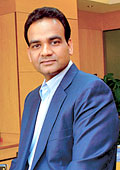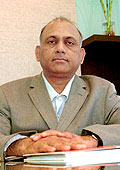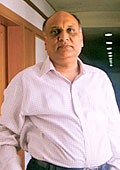|
India's Fastest Growing
Large Companies
Companies with revenues in excess of Rs 1,500
crore that grew the fastest in 2006.
FASTEST GROWING LARGE COMPANIES
»
Hindustan Zinc
» Welspun Gujarat
Stahl Rohren
» Unitech
» Pantaloon
Retail (India)
» UltraTech
Cement
» Gujarat Ambuja
Cements
» Nagarjuna
Construction Co.
» Aurobindo
Pharma
» Hindalco
Industries
» United Spirits
1.
Hindustan Zinc
The former PSU's burgeoning profits
would have you believe that what it churns out is not zinc, but
cash.
 |
| Hindustan Zinc’s
Anil Agarwal: Same assets, but vastly different results |
Critics of disinvestment,
eat your heart out. Public sector units (PSUs) are indeed better
off in private hands. Want proof? Just take a look at Hindustan
Zinc. Back in April 2002, when Anil Agarwal-controlled Vedanta
Resources took over the state-owned enterprise, it had a net profit
of Rs 68 crore and revenues of Rs 1,929 crore. In 2005-06, Hindustan
Zinc reported a bottom line of Rs 1,472.5 crore and a topline
of Rs 4,327 crore, and for the nine months ended December 31,
2006, the former psu cranked up net profit to a staggering Rs
3,507 crore, and revenues to Rs 6,531 crore. No doubt, the boom
in commodity prices has helped the company, but there's more to
its stunning growth story. "We were quick to exploit the
best resources and unlock the true potential of our mines, which
are among the best in the world," says Agarwal, Chairman,
Vedanta, adding that increasing operational efficiency and giving
a free hand and more responsibility to employees has raised productivity.
The company is currently the third largest producer of zinc in
the world but also produces lead, 100 tonnes of silver and is
the biggest producer of sulphuric acid in India. Agarwal's ambition:
To be the world's biggest and lowest-cost producer of zinc. "By
2010, we should be producing one million tonnes (from 4 lakh tonnes
currently) of zinc and lead," he says. With per capita zinc
consumption already at double digits, and demand growing at almost
4 per cent a year in India, Hindustan Zinc's glittering performance
may well be here to stay.
-Mahesh Nayak
 |
| Welspun’s B.K. Goenka:
Will soon also make steel for pipes |
2.
Welspun Gujarat Stahl Rohren
This oil and gas pipe maker is now a global
vendor.
Every time energy
majors such as chevron and Saudi Aramco buy pipes for their oil
and gas business, they first make a call to Mumbai-based Welspun
Gujarat Stahl Rohren (WGSR). That's not just because the Indian
company makes large diameter pipes (which require top skills),
but also because it has an exclusive agreement with them for supplies.
Not bad for a company that got into the pipes business just over
a decade ago. "It hasn't been easy, we had to fight hard
with the government to break the tough regulatory and monopolistic
environment in India," says B.K. Goenka, Vice Chairman and
Managing Director, WGSR.
The fight's been worth it. Nearly 75 per
cent of WGSR's Rs 1,940 crore in revenues comes from exports,
and the order book for the next 12-15 months is at $1 billion
(Rs 4,300 crore). "Every quarter our order book grows at
least 30-40 per cent of total revenues," says Akhil Jindal,
President, Welspun Group. Last calendar year, WGSR increased net
profit by 176 per cent to Rs 120.5 crore, and revenues by 68.6
per cent from Rs 1,533 crore to Rs 2,585 crore. When its backward
integration into steel (for pipes) is completed by December 2007,
operating profit margins are expected to improve to 16 per cent
from 13 per cent currently. But what has Goenka grinning from
ear to ear is the fact that, over the next five years, the replacement
market in the US alone could generate demand for one million miles
of pipes.
-Mahesh Nayak
3.
Unitech
It may survive a downturn in real estate better.
 |
| Unitech’s Chandra:
Aiming for higher growth rate |
The real estate
sector in India was on fire in 2006. And so was Unitech, one of
the oldest listed real estate firms in the country. It clocked
more than 1,500 per cent increase in net profit and a 230 per
cent increase in sales. Of course, these numbers were clocked
on a relatively modest base of the previous years. Managing Director
Sanjay Chandra believes the year represented the usual buoyancy
of the real estate business and the fact that the company expanded
into newer markets such as Greater Noida in the last few years.
The company delivered upwards of 3 million sq ft. in 2005-06 and
is expected to have more than doubled it up with nearly 8 million
sq ft. in 2006-07, according to analysts.
But will 2007 be as good as 2006? "No,
but Unitech will show a growth rate higher than that clocked by
the industry," says Chandra. How? For one, he expects past
growth to sustain over the next four to five years, as sales from
new residential markets such as Noida and Kolkata start showing
up on the balance sheet. Going forward, the company plans to start
selling in new markets every two months. "(The number of
apartments) being put up for sale would double every year for
the next 3-4 years," says Chandra. Higher interest rates
may knock out some builders, but perhaps not Unitech.
-Shalini S. Dagar
 |
| Pantaloon’s Biyani:
He’s still #1, but maybe not for too long |
4.
Pantaloon Retail
It is a Wal-Mart wannabe, but now must fight
the giant itself.
The organised
retail industry has always scoffed at Pantaloon Retail's Kishore
Biyani and the man in turn has continued to believe in himself
and his unconventional strategies. So far, Biyani has been proved
right. His retail empire-which includes the Big Bazaar hypermarket
chain, Pantaloon stores, Central (malls), and a newly-launched
Hometown store for home improvement-is currently the biggest in
the country, with revenues of Rs 2,387 crore (Jan-December, 2006)
and a net profit of Rs 115 crore. "We plan to double our
growth year after year from here," says Biyani. "We
are working towards building an organisation that functions in
almost all categories of retail."
Pantaloon Retail has 5 million sq. ft of
retail space across the country, but Biyani hopes to double it
by March 2008 and take it to 30 million sq. ft by 2010. Accordingly,
he plans to invest $1 billion over the next four years for this
expansion. "We are looking at divesting some of our subsidiaries
to raise this amount to fuel our expansion plans," says Biyani.
According to him, Rs 2,000 crore will come from internal accruals
and Rs 2,500 crore will be through divestment of subsidiaries
and debt. With two heavyweights-Reliance Retail and Bharti-Wal-Mart-entering
the fray, Biyani's dreams of becoming India's Wal-Mart remain
just that. But you can be sure he'll try his best. For starters,
he's even launching KB's Wholesale Market, aimed at small rural
retailers. His inspiration, no doubt, comes from Sam's Club, a
Wal-Mart wholesale format named after the man who founded it:
Sam Walton.
-Anusha Subramanian
5.
UltraTech Cement
It's riding the infrastructure boom.
 |
| D.D. Rathi: The man
driving UltraTech |
Over the next
five years, India will invest some $350 billion in infrastructure.
That's a lot of money, but that's also a lot of cement. Not surprisingly,
Kumar Mangalam Birla, Chairman of the Aditya Birla Group, which
owns UltraTech via subsidiary Grasim Industries, is ramping up
capacities. "The company has earmarked a capex of Rs 1,424
crore, which will be spent over the next three years," he
mentioned this in a letter to UltraTech shareholders in 2006.
According to an ICRA report, production in
the cement industry increased at 8.1 per cent a year between 1981
and 2004, making India the second largest producer in the world
after China. The pace of expansion may be faster in the years
ahead, since even the projected $350 billion of investment may
not be sufficient to bring India's infrastructure to world standards.
Meanwhile, UltraTech, formerly L&T Cement acquired by the
Birlas and now led by D.D. Rathi, is clipping. Its April-March
2006 revenues rose 27 per cent over the same period the previous
year to Rs 3,299 crore, while net profit jumped 7,567 per cent
to Rs 230 crore. The government's recent order to cement companies
to hold prices has hit investor sentiment, but that's unlikely
to be a long-term problem.
-Krishna Gopalan
 |
| Gujarat Ambuja’s
Singhvi: The focus is retail market |
6.
Gujarat Ambuja Cements
As a Holcim company, it can only do better
here on.
In a recent report,
Citigroup analysts have recommended a hold on the Gujarat Ambuja
stock. That doesn't bother its Managing Director, Anil Singhvi,
the least. Why? As the Citi report itself notes, Gujarat Ambuja
"enjoys relatively high EBITDA margins due to its focus on
the retail cement market (where prices are better), modern plants
with low power and fuel consumption and the use of sea transport."
Besides, the company's capacity utilisation is a high 90 per cent.
"The industry produced 152 million tonnes of cement in 2006,
and we believe that cement demand should grow by 10 per cent in
2007," the company's Chairman, Suresh Neotia, told shareholders
recently.
That explains why Gujarat Ambuja, where Swiss
cement giant Holcim is now the majority owner, is expanding its
clinker capacity by 4.5 million tonnes and cement capacity by
6 million tonnes. Upon completion in mid-2009, the expansion will
raise Gujarat Ambuja's cement capacity to 22 million tonnes from
16 million tonnes at present. Says Singhvi: "Our focus will
be on providing best quality cement, good packaging, having a
strong distribution network and customer service."
Already, the boom in housing and infrastructure
has begun showing up on Gujarat Ambuja's books. In January-December
2006 (which is also the company's financial year), net profit
more than tripled to Rs 1,503 crore. Revenues too jumped to Rs
4,848 crore from Rs 3,296 crore the year before. Despite control
on prices, the outlook for this year, says Neotia, is good. The
only threat may be an overall slowdown.
-Krishna Gopalan
7.
Nagarjuna Construction
The firm's order book is brimming over.
 |
| Nagarjuna’s Raju:
Buoyed by infrastructure projects |
Back in 2000-01,
Hyderabad-based Nagarjuna Construction was a small Rs 250-crore
firm. But when the results for 2006-07 come out, Nagarjuna could
report a topline of Rs 3,000 crore and a net profit of Rs 150
crore. "Based on the order back log (Rs 7,025 crore, end
of 2006) and the future prospects, we are confident of a topline
growth of 30-35 per cent and a bottom line growth of 40 to 45
per cent over the next three years," says Alluri Ranga Raju,
50, Managing Director of Nagarjuna. That means in another two
years, Nagarjuna, which also featured on our fastest growing list
last year, could become a billion-dollar construction major.
Where will the growth come from? "We
expect the key growth drivers to be projects in roads, buildings,
electricals, irrigation other than some of our new divisions like
metals, power and oil and gas," says Y.D. Murthy, Senior
Vice President (finance and accounts), Nagarjuna. Starting 2008,
the company intends to bid for civil, electrical, mechanical works
in the oil and gas sector, besides gas pipelines. At present,
central and state governments and their undertakings account for
around 90 per cent of its order book. It took Nagarjuna 16 years
to hit Rs 100 crore in revenues (1995), but if its growth momentum
sustains, it could be a Rs 10,000 crore company by 2012.
-E. Kumar Sharma
 |
| Aurobindo’s Reddy:
Betting on exports |
8.
Aurobindo Pharma
It's moving more towards generic drugs.
A billion dollars
in revenues by 2009-10 and a more profitable product mix. That's
the mantra executives at Hyderabad-based pharma company, Aurobindo
Pharma, are chanting these days. Expected to report a 46 per cent
increase in revenues to Rs 2,200 crore in 2006-07, Aurobindo,
which claims to be India's largest bulk drugs exporter, now wants
to grow its presence in cardio vascular and central nervous system
drugs, and do more of formulations (that is, finished drugs),
especially in the global generics market, where patent expiries
and rising healthcare costs are making generics popular.
An important part of that strategy is global
acquisitions. Last year alone, Aurobindo made three acquisitions,
including Milpharm in the UK, Pharmacin International B.V. in
the Netherlands, and a manufacturing facility in New Jersey from
Sandoz (a Novartis company). Having a us FDA-certified manufacturing
facility in the us will allow Aurobindo to get business from the
us government and manufacture controlled substances such as those
for sustained release medication. Already, the company, founded
by P.V. Ramaprasad Reddy in 1986, gets 62 per cent of its revenues
from sales abroad. If its plans in formulations pay off, then
not just its revenues but profits will go up. A nice recipe, no
doubt.
-E. Kumar Sharma
9.
Hindalco Industries
With Novelis in its bag, the aluminium maker
is set to go places.
 |
| Kumar Mangalam Birla:
Acquisition is the way to grow |
My way is the
global highway. Hindalco industries chairman Kumar Mangalam Birla
hasn't said that in so many words, but his actions drive home
his intent. In the second week of February, when Birla agreed
to pay a stunning $6 billion for Atlanta-based aluminium major
Novelis, many analysts were sceptical of the deal price. Hindalco's
stock fell in response, but Birla remains unfazed. "In both
the aluminium and copper businesses, we are well-positioned to
grow. Hindalco's excellent performance is testimony to the high
operating benchmarks that it has set for itself," he says.
The numbers are indeed impressive. In October-December 2006, for
instance, Hindalco's total income grew to Rs 4,714 crore from
Rs 2,916 crore in the same quarter the year before, while the
net profit jumped from Rs 336.2 crore to Rs 643.9 crore.
With a robust local market and a huge access
to Novelis' global clients, including Kodak and Coca-Cola, Hindalco's
road to becoming a global aluminium major looks rather interesting.
"The Novelis acquisition gives us scale and a global footprint
immediately," says Hindalco's Managing Director, Debu Bhattacharya.
That apart, Hindalco plans to set up an aluminium smelter in Madhya
Pradesh at a cost of Rs 7,000 crore. Recently, Hindalco announced
their joint venture with Almex in the USA to manufacture high
strength aluminium alloys. This will give Hindalco a foothold
in the lucrative aerospace and surface transport markets. With
so much afoot, Birla has reason to be bullish about his global
gambit.
-Krishna Gopalan
 |
| United Spirits’ Rekhi:
Consolidating to stay on top |
10.
United Spirits
Vijay Mallya's liquor company is soaring high.
The world's second
largest spirits company (after Diageo) is on a roll. When in mid-2005
Vijay Mallya, the flamboyant Chairman of UB Group, integrated
all his spirits companies by merging McDowell, Phipson Distillery,
Baramati Grape Industries and Shaw Wallace's distillery division,
which he had brought under the United Spirits banner, he created
a liquor powerhouse. Some of the synergies are becoming evident.
Over the last eight quarters, the company has consistently grown
its gross profits in high double digits. For the nine months ended
December 31, 2006, the company earned a net profit of Rs 443.97
crore on a turnover of Rs 2,060.4 crore-that's an increase of
20 times in net profit and a 40 per cent jump in turnover over
the same period the previous year. Credit the extraordinary profit
growth on the synergies from the mergers. According to United
Spirits' President Vijay Rekhi, savings in packaging costs fetched
Rs 17 crore, changes in sourcing another Rs 5 crore, better raw
material pricing Rs 40 crore and savings in trade spends another
Rs 40 crore.
With more than seven brands that sell in
excess of a million cases each annually (total sales: 60 million
cases, of which each has 12 bottles), United Spirits is looking
to widen its geographical footprint. However, it is the acquisition
of Scottish distiller Whyte & McKay that everyone's looking
forward to. If the billion-dollar deal happens, United Spirits
will turn into a truly global liquor powerhouse.
-Venkatesha Babu
India's Fastest Growing
mid-sized Companies
Companies with revenues between Rs 1,000 crore
and Rs 1,499 crore that grew the fastest in 2006.
FASTEST
GROWING MID-SIZED COMPANIES
»
Kalpataru
Power Transmission
»
Shree Cement
»
Hindustan Copper
»
Centurion Bank of Punjab
»
Man Industries (India)
1.
Kalpataru Power
It wants much more of the infrastructure projects.
 |
| Kalpataru Power’s
Munot: Powering up |
How's this for
performance? What Kalpataru Power Transmission earned in a single
month in March 2006 used to be its full-year revenue as recently
as 2001. But back then, Mumbai-based Kalpataru used to be a small
firm whose only business was to lay transmission lines. These
days, it builds everything from bridges to roads, besides power
lines. "We are attacking more parts of the infrastructure
pie, thus ensuring faster growth within the company," says
Ajay Munot, Executive Director, Kalpataru. For 2006-07, the company
is expected to clock revenues of Rs 2,000 crore, of which Rs 500
crore will come from JMC Projects, a construction firm that it
acquired in February 2005. In 2005-06, the 27-year-old company
had consolidated revenues of Rs 1,100 crore.
Munot, 35, knows exactly what is driving
growth at Kalpataru. "Government spending on infrastructure,
acquisition of JMC Projects, diversification into multiple sectors
and locations, and execution capabilities have been the key reasons
behind our success," says Munot. Kalpataru's order book for
the next 12-18 months is almost as much as its last two years'
revenues (Rs 3,000 crore), but Munot plans to focus more on the
export market, specially in Africa, and venture into different
verticals in infrastructure space. "Next year, we will grow
at 30-35 per cent with a similar growth in our order book,"
says Munot. Looks like Kalpataru is going to be on our list next
year as well.
-Mahesh Nayak
 |
| Shree Cement’s Bangur:
Conservative, yet strong fundamentals |
2.
Shree Cement
It believes in chasing shareholder value,
not size.
If you ask H.M.
Bangur, managing director of Kolkata-based Shree Cement, what
drives things at his company, he'll tell you that it's not the
quest for size or bottom line, but shareholder value. "If
you adopt the right business practices and concentrate on production,
efficiency and quality, profits will come automatically,"
Bangur rationalises. And he's right. Shree's revenues have gone
up from Rs 506.93 crore in 2003-04 to a projected Rs 1,350 crore
in 2006-07-a compounded annual growth rate of over 30 per cent.
Similarly, the bottom line has grown at a CAGR of nearly 130 per
cent to an expected Rs 200 crore. The company has been expanding
its manufacturing capacity since 2004, and the process continues.
For instance, its capacity of 4.8 million tonnes will be increased
to 6.8 million tonnes by April next year, and eventually 20 million
tonnes by 2015. What's interesting, though, is that Shree won't
be expanding its capital base in the process. The company has
already consolidated its position in north India, but isn't averse
to tapping opportunities overseas either. Shree's management philosophy
may sound conservative and quaint, but its performance is anything
but old-fashioned.
-Ritwik Mukherjee
3.
Hindustan Copper
The PSU is aiming for reinvention.
 |
| Hindustan Copper’s
Gupta: Shifting focus to mining |
Over the last
one year, things at "Tamra Bhawan", Hindustan Copper's
headquarters in Kolkata, haven't been as PSU-ish as they usually
are. Revenue and profit figures, for one, have been surging. In
the third quarter of 2006-07 (October-December, 2006), the state-owned
company's year-on-year bottom line soared 389 per cent to Rs 131.60
crore, and sales increased 84 per cent to Rs 551.89 crore. The
company, once known for its losses and worker strife, has turned
a new leaf, and is talking of a new strategy, which involves shifting
focus from copper making to mining. "If we are to survive
and prosper, the focus has got to be on mining and acquisition
of more deposits in the country," says Satish Chandra Gupta,
its Chairman and Managing Director. The larger strategy involves
arresting decline (by 2006-07), consolidation (between 2007 and
2010), and expansion (starting 2010). Leveraging it, selling off
idle assets and inducting fresh talent are some other aspects
of the new strategy that will make Hindustan Copper look less
and less like a PSU.
-Ritwik Mukherjee
 |
| Centurion Bank’s
Bhandari: Sees more growth coming from SMEs |
4.
Centurion Bank of Punjab
Acquisitions have transformed the bank's fortunes.
Four years ago,
centurion bank was tottering on the brink. Today, with 279 branches
and 409 ATMs, it's the fastest growing bank in the country. "We
are growing almost two times the market pace," quips Shailendra
Bhandari, CEO and Managing Director of Centurion Bank. If you
take the December quarter numbers, which include those of Bank
of Punjab that it acquired in 2005, then Centurion's advances
are growing at 66 per cent, compared to an industry average of
31 per cent. Similarly, net profit grew by 46 per cent against
industry average of 21 per cent.
But the question is, with interest rates
rising, will Centurion, 69 per cent of whose lending is to retail
consumers, continue to churn out such numbers? "We are committed
to growing at a multiple of the market," says Bhandari. That
would mean having to find ways to keep two-wheeler, commercial
vehicle and construction equipment buyers, who make up two-thirds
of retail borrowers, coming back to Centurion for loans. But Bhandari
also says that a lot of growth will come from small and medium
enterprises (SMEs) that, along with biggger corporate borrowers,
make up the other 31 per cent of Centurion's overall lending.
The bank also has a sizeable fee-based income
that comes from marketing two dozen mutual funds, life insurance
policies of Aviva Life Insurance, and general insurance products
of ICICI Lombard, among others. But Rana Talwar, Standard Chartered's
former global CEO and the man who turned around Centurion's fortunes
after he bought it in 2003, may be planning more acquisitions
to gain critical mass. Of course, he will have to wait for the
RBI to open up M&As in the industry in 2009.
-Anand Adhikari
5.
Man Industries
A pipe maker comes of age.
 |
| Man Industries’ Mansukhani:
No pipe dream |
These days R.C.
Mansukhani, chairman of Man Industries, doesn't grab every order
that comes his way. He's become far more choosy, going only after
projects that offer better margins. Thanks is due to the booming
global oil and gas industry, where refiners are spending billions
of dollars in laying and relaying pipelines. Admits Mansukhani:
"The buoyancy in the industry and our capability to execute
projects at low cost have made us choosy in selecting projects."
In 2006-07, Man is expected to grow its topline 41 per cent to
Rs 1,200 crore, with exports fetching 75 per cent of the revenues.
To maintain its momentum and execute orders
on time, the company is increasing its capacity by a quarter to
2,500 km of pipes at its plant in Anjar, Gujarat. And there's
plenty of work to keep the plant busy. Man has an order book of
Rs 2,200 crore, of which Rs 1,000 crore worth of orders came just
last quarter from Kinder Morgan, one of the largest midstream
energy companies in America. "We are targeting a growth of
90 per cent this year that will see our revenue topping Rs 2,000
crore by 2007-08," says Mansukhani. That's a growth even
the IT big-wigs would be hard-pressed to match.
-Mahesh Nayak
India's Fastest Growing
Small Companies
Companies with revenues less than Rs 999 crore
that grew the fastest in 2006.
FASTEST GROWING SMALL COMPANIES
»
Era Constructions (India)
» Asian Electronics
» ICSA (India)
» ORG Informatics
» Ansal Housing
1.
Era Constructions
Making the leap from contracting business
to turnkey (EPC) contracts and then to manufacturing pre-engineered
building systems has paid off handsomely for the Delhi-based infrastructure
builder, Era Constructions. Its Pantnagar (Uttaranchal) facility,
for instance, has slashed procurement costs and product delivery
time in turnkey contracts. Says H.S. Bharana, Era's Managing Director:
"Pre-engineered building is the way construction is done
in developed countries, and India is following suit." Result:
Era's 2006-07 standalone revenues are set to touch Rs 700 crore
from Rs 313 crore the previous year, while group revenues (it
has two other real estate firms, Era Infrastructure and Era e-Zone)
should touch Rs 1,100 crore, up 192 per cent. What's more, Bharana
expects a 100 per cent annual growth over the next three years.
-Kapil Bajaj
2.
Asian Electronics
Jinendra Shah, executive Director of Asian
Electronics, just can't stop grinning. The third quarter (October-December)
numbers have been so good that they add up to more than what the
energy saving lighting product manufacturer reported in the previous
nine months combined. Revenues touched Rs 104.1 crore and net
profit Rs 18.9 crore. "Although our energy services business
involves a huge capex, the returns are equally rewarding,"
says Shah. Among the recent orders include one from the Prime
Minister's Office for energy efficient lighting, and two others
from the labour and transport ministries for their offices. Thanks
to its recent purchase of an Irish company, STS PCB, Asian will
now get a small toehold in western markets. Shah says this is
just the beginning. Asian is talking of 2007-08 revenues in excess
of Rs 500 crore.
-Pallavi Srivastava
3.
ICSA (India)
The distance from NBFC to utlities may be
a long one for most people, but not G. Bala Reddy. In 1998, he
bought a loss-making NBFC and over the years has turned it into
a fast-growing provider of embedded solutions to power, oil and
gas, and water companies. One of its products, the ICAP, for instance,
is an onsite pipeline monitoring device that keeps track of the
pipeline's health. "Moving into infrastructure has helped
us grow over the last three years," says Reddy, ICSA's employee-turned-owner.
Revenues are up from a mere Rs 21.51 crore in 2004-05 to Rs 229
crore between April-December, 2006. The company has recently raised
about Rs 280 crore, of which Rs 150 crore is earmarked for acquiring
other companies and the rest is for R&D and working capital
needs.
-E. Kumar Sharma
4.
ORG Informatics
It's a good time to be a telecom solutions
provider. Just ask Ajoy Khandheria, MD & CEO of Gurgaon-based
org Informatics. Its 2006-07 revenues are set to top Rs 300 crore,
compared to Rs 156.41 crore the previous year. Net profit will
jump to Rs 15 crore from Rs 8.10 crore. Systems integration contributes
80 per cent of the revenues, with the remainder coming from software
and managed services. "There is phenomenal growth in each
of the three areas we have presence in. Telecom operators worldwide
are upgrading their infrastructure. So the business will continue
to grow at a fast clip," says Khandheria.
-Kapil Bajaj
5.
Ansal Housing
As interest rates harden and the RBI moves
to suck out speculative money from the property market, is the
party over for builders? "No," says Kushagr Ansal, Director,
Ansal Housing and Construction, which should be posting a 50 per
cent growth in topline to Rs 190 crore and over 90 per cent rise
in net profit to Rs 40 crore in 2006-07. "We have invested
a lot of money in developing projects and those investments are
paying off now," says the MBA from Bentley College in the
us. With Rs 6,000 crore worth of projects on its plate, Ansal
expects to grow revenues to Rs 350 crore in 2007-08. "India's
needs for construction are enormous," says Ansal. He's right.
-Kapil Bajaj
|



















